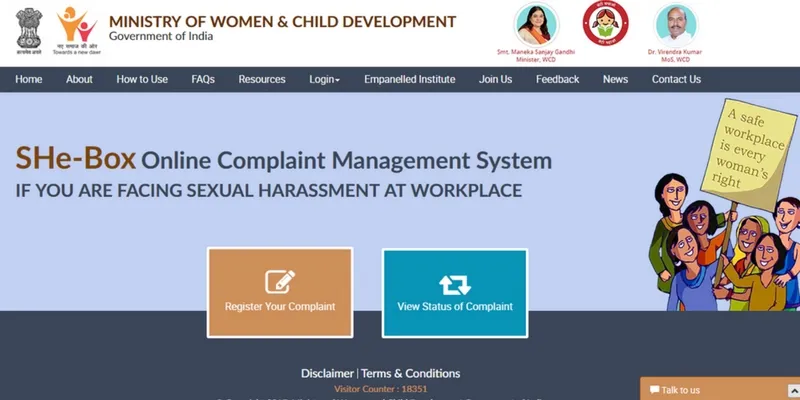Why SHe-Box will get a thumbs-up from the working women of India
Last year, the #MeToo campaign opened the eyes of the world on how deep-rooted and rampant sexual harassment is, and how important it is to report and talk about it.
When it comes to reporting, the average Indian woman – typically one who is earning barely enough money to make ends meet – may probably not even be aware that she can complain against the perpetrator of this repugnant crime.
Which is why when the Ministry for Women & Child Development (WCD) launched ‘SHe-Box’ this year, it presaged the beginning of a new and progressive era for women in the Indian workforce. The platform could be the game-changer for women encountering sexual harassment at the workplace in India. SHe-Box (Sexual Harassment Electronic Box) is an online complaint management system launched in July 2017, specifically for documenting and redressing grievances on sexual harassment for female government employees.
On November 7, 2017, its coverage was extended by the WCD Ministry to female employees in the private sector as well, increasing its scope and usefulness. A female employee who is a victim of sexual harassment can raise a complaint on SHe-Box either before or after raising it with their respective organisations’ Internal Committee (IC) or Local Committee (LC).

Image: Shutterstock
What is SHe-Box, and how is it useful?
The SHe-Box initiative underscores the government mandate that organizations stay compliant with the Sexual Harassment of Women at Workplace (Prevention, Prohibition and Redressal) Act, 2013 (aka, the POSH law), consider the issue of sexual harassment against women very seriously, and take the necessary action to ensure that the workplace is safe for female employees.
Raising awareness: It brings about with it an awareness of the topic which is still quite a taboo in India, and will hopefully embolden women to raise their complaints, rather than remain silent. The platform aligns with the EEOC (Equal Employment Opportunity Commission) in the US.
India had only 500 reported complaints of sexual harassment at the workplace last year, drastically lower when compared to the 27,000 complaints reported in the US. One hopes that SHe-Box will encourage more women to come forward to name perpetrators and seek justice.
Ensure fairness and action: The Sexual Harassment Act mandates that workplaces with more than 10 workers constitute an internal complaints committee for receiving complaints of sexual harassment. SHe-Box stands over and above the whims of an organisation, as the Internal Committee’s/Local Committee’s functioning “may” be at the mercy of the organisation. These Committees will be increasingly under pressure to ensure that they execute their responsibility adequately, as they could be monitored.
Independent and external assistance: SHe-Box also provides a forum outside the organization for female employees to complain to. Earlier, in the case of an unresponsive organisation, the only option was to lodge a complaint with the police. With the complaints being monitored in SHe-Box, organizations will step up their efforts to ensure that they provide a safe workplace to female employees.
Data analysis and convenience: SHe-Box will also help the Indian government track the number of incidents and understand the magnitude of the problem. Finally, a victim could always report to other authorities through a physical document or an email. A portal provides convenience. In addition, the SHe-Box portal is fairly user-friendly.

How SHe-Box can be made more effective
While a great system, there are a few shortcomings that should be rectified to make the portal even more effective:
Confidentiality: However well-intentioned such a system is, unless it ensures utmost confidentiality, female employees will hesitate to utilize it. Any indication on the portal to confirm confidentiality will be reassuring to a victim raising a complaint.
Provisioning for whistle-blowers: The portal only allows a victim to lodge a complaint. If a whistle-blower section was to be added, it could prove to be vital. In a country where the stigma of calling out the perpetrator is quite severe, an option for a person other than a victim to register a complaint via this portal could be crucial to its success.
Handling unknown or multiple respondent(s): Currently, there is no provision to submit a complaint against an unknown respondent, i.e., someone whose identity may be unclear to the victim. For example, a vendor who was in the workplace on the day of the incident, a person from another department or company who was at the shared cafeteria or parking area, etc. Also, a provision to complain against multiple respondents needs to be included for the SHe-Box to be comprehensive.
Intimidating for the lower strata: It is a reality that those from the lower strata of Indian society might find an online portal intimidating, and may need to take the help of someone else in order to use the portal. If the portal allows a written complaint to be scanned and uploaded, it would help.
Mandatory Aadhaar number: Mentioning the Aadhaar number is mandatory in SHe-Box. Would this make sexual harassment victims wary of lodging the complaint on the portal? We don’t know. How mandating the Aadhaar card number in SHe-Box works vis-a-vis the right to privacy is also yet to be understood. It would help if the Aadhar card number were to be made optional to alleviate the fears of the victim.
Clarity of process and scope: Certain aspects of SHe-Box and its process and coverage are still unclear. For example, when the WCD Ministry forwards the complaint received on the portal to the concerned organisation, who at the organisation receives it? Perhaps having a dedicated role or mentioning who is responsible for receiving and following up on the complaint is required. Also, there needs to be improved scope for consultation and assistance, especially in the unorganised sector.
Finally, as seen in the case of Harvey Weinstein, sometimes, perpetrators can harass a lot of victims before they are eventually revealed to the world. In such a case, SHe-Box should have a facility where a group of victims of the same perpetrator can sue them together as a group, or ‘class action’.
Women in India are vulnerable to the fear of being ostracized socially when they complain against sexual harassment. They fear to lose their indispensable financial income, the backlash at the workplace, and a lot more. The normal Indian woman has long been conditioned to quit the workplace rather than raise a complaint, a choice akin to the lesser of two evils. SHe-Box is a step in the right direction to challenge this status quo and to finally give the Indian working women the fair representation and support they deserve.
(Disclaimer: The views and opinions expressed in this article are those of the author and do not necessarily reflect the views of YourStory.)







